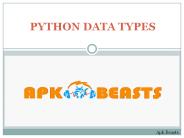Comparing Data - PowerPoint PPT Presentation
Title:
Comparing Data
Description:
When comparing data using boolean expressions, it's important ... 'book' comes before 'bookcase' Comparing ... strings regardless of the case. In this case ... – PowerPoint PPT presentation
Number of Views:151
Avg rating:3.0/5.0
Title: Comparing Data
1
Comparing Data
- Comparing More than Numbers
2
Comparing Data
- When comparing data using boolean expressions,
it's important to understand the nuances of
certain data types - Let's examine some key situations
- Comparing floating point values for equality
- Comparing characters
- Comparing strings (alphabetical order)
- Comparing object vs. comparing object references
3
Comparing Float Values
- You should rarely use the equality operator ()
when comparing two floating point values (float
or double) - Two floating point values are equal only if their
underlying binary representations match exactly - Computations often result in slight differences
that may be irrelevant - In many situations, you might consider two
floating point numbers to be "close enough" even
if they aren't exactly equal
4
Comparing Float Values
- To determine the equality of two floats, you may
want to use the following technique
if (Math.abs(f1 - f2) lt TOLERANCE)
System.out.println ("Essentially equal")
- If the difference between the two floating point
values is less than the tolerance, they are
considered to be equal - The tolerance could be set to any appropriate
level, such as 0.000001
5
Comparing Characters
- In Unicode, the digit characters (0-9) are
contiguous and in order - Likewise, the uppercase letters (A-Z) and
lowercase letters (a-z) are contiguous and in
order
Characters Unicode Values
0 9 48 through 57
A Z 65 through 90
a z 97 through 122
6
The .equals method
- Remember that in Java a character string is an
object - The equals method can be called with strings to
determine if two strings contain exactly the same
characters in the same order - The equals method returns a boolean result
if (name1.equals(name2)) System.out.println
("Same name")
7
The .compareTo method
- We cannot use the relational operators to compare
strings - The String class contains a method called
compareTo to determine if one string comes before
another - A call to name1.compareTo(name2)
- returns zero if name1 and name2 are equal
(contain the same characters) - returns a negative value if name1 is less than
name2 - returns a positive value if name1 is greater than
name2
8
Comparing Strings
if (name1.compareTo(name2) lt 0)
System.out.println (name1 "comes
first") else if (name1.compareTo(name2)
0) System.out.println ("Same name")
else System.out.println (name2
"comes first")
- Because comparing characters and strings is based
on a character set, it is called a lexicographic
ordering
9
Lexicographic Ordering
- Lexicographic ordering is not strictly
alphabetical when uppercase and lowercase
characters are mixed - For example, the string "Great" comes before the
string "fantastic" because all of the uppercase
letters come before all of the lowercase letters
in Unicode - Also, short strings come before longer strings
with the same prefix (lexicographically) - Therefore "book" comes before "bookcase"
10
Comparing Objects
- The operator can be applied to objects it
returns true if the two references are aliases of
each other - It has been redefined in the String class to
compare the characters in the two strings - When you write a class, you can redefine the
equals method to return true under whatever
conditions are appropriate
11
Comparing Strings
- The equalsIgnoreCase method
- Will compare two strings regardless of the case
- In this case
- Java, JAVA and java will all be equal.
12
Comparing Characters
- As we've discussed, Java character data is based
on the Unicode character set - Unicode establishes a particular numeric value
for each character, and therefore an ordering - We can use relational operators on character data
based on this ordering - For example, the character '' is less than the
character 'J' because it comes before it in the
Unicode character set - Unicode Table
13
Questions?
comparing strings
comparing floats
comparing characters































